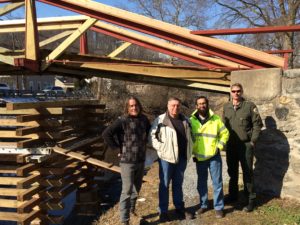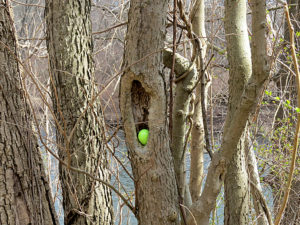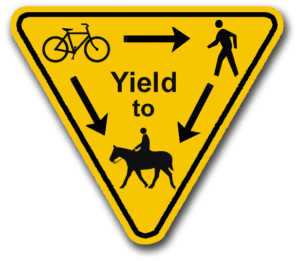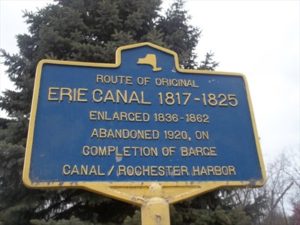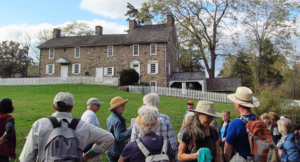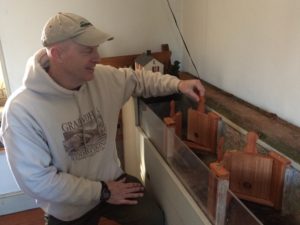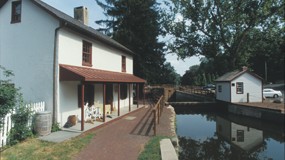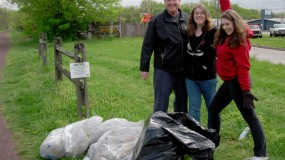Canal News – Late Winter 2024
Family-Friendly Towpath Adventures
Discover History on the Towpath
As temperatures rise and days get longer, it’s time to get outdoors and there is no better place than the Delaware Canal and Towpath. This 58.9-mile greenway is a great place to connect with nature and history.
There are many interesting things to see on the canal, but we are highlighting a few of our favorites to explore. We like them because they have nearby parking, some have restrooms or a portable toilet, and all provide an interactive experience where the whole family can investigate remnants of our past.
It is worth noting that before you venture out for any long-distance adventure, check the park’s closure updates (right now there are many) or our website under breaking news. Or call the Friends for advice.
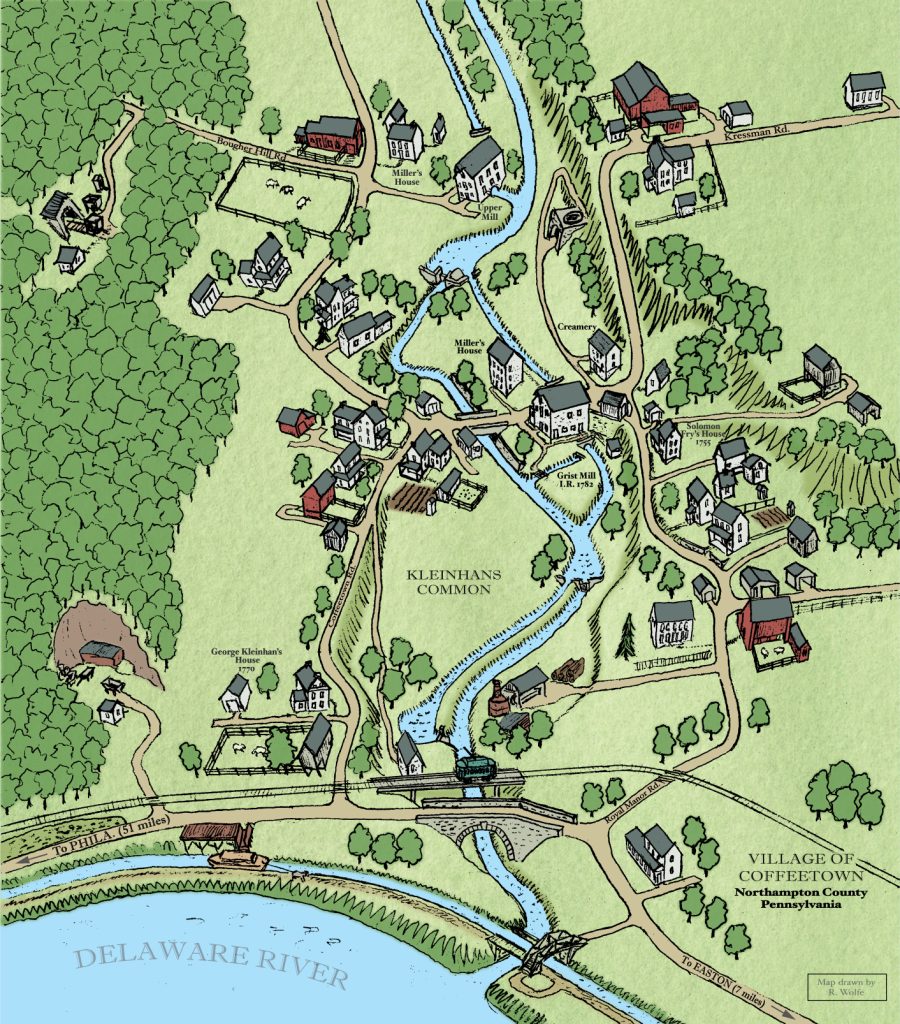 A Visit to Coffeetown and Fry’s RunAqueduct: Mile Marker 52
A Visit to Coffeetown and Fry’s RunAqueduct: Mile Marker 52
If you live in the northern section of the canal, closer to Easton, there are many landmarks along the way. Kleinhan’s Aqueduct and Fry’s Run, the stream that travels through the aqueduct to the river, are located at mile marker 52. This area is also called Coffeetown, known for a few enterprising women who roasted a mix of grains to mimic the taste of coffee. Coffee was a rare and pricey commodity and out of reach of most farmers and villagers.
Fry’s Run once powered grist mills and lumber mills and the area called Coffeetown developed into a small village by the late 1800s which included retail establishments, a school and a post office along with thriving industries.
Today, the village is commemorated at Fry’s Run Park with an exhibit that tells the story of Coffeetown. There’s also an observation deck, and remnants of a stone arch bridge, the oldest bridge in Northampton County which still provides a nice walking path and view of the creek.
What to look for when you visit:
• Fry’s Run Park with interpretive displays
• The 198-year-old stone M. Opp Bridge
• Fry’s Run (aka Kleinhans) Aqueduct and footbridge
• Overlook deck at Fry’s Run Park (built on the remnants of an old trolley line)
Uhlerstown, “The Best Preserved Hamlet in America”: Mile Marker 40
Further south near mile markers 39 and 40, you will find the hamlet of Uhlerstown. Parking is located in the nearby Tinicum Park, a mile from the Uhlerstown Historic District.
Named for Michael Uhler, this quaint and well-preserved piece of history was once a thriving industrial village, home to a lumber mill, grist mill, lime kilns, a boat building and repair yard, a stable and a hotel with a colorful past. Michael Uhler also built the mansion which is situated close to the base of the cliff. This home was one of the show places along the canal.
On a visit to this hamlet, you will find the Uhlerstown covered bridge, the only one over the Canal. The bridge is called a “lattice type” and records show that it was in use in 1832. Windows on the sides of the bridge are another unique feature.
The Uhlerstown Hotel, built about 1840, is now a private residence as is the Uhlerstown Hall. The Locktender’s House and lock are also worth seeing as are the remnants of the lime kilns.
Uhlerstown is a historic district that includes surrounding agricultural land. If you tour the area, please keep in mind that these are private residences.
What to look for when you visit:
• Uhler’s Mansion
• Covered bridge
• Lime kilns
• Lock 16 and the Locktender’s House, which is a private residence
Washington Crossing Historic Park, A National Treasure: Mile Marker 23
This historic park encompasses approximately 500 acres with many well-preserved points of interest and significance. The park is generally divided into the north and south sections. In the northern section, you will find Bowman’s Tower, the Thompson-Neely House and Gristmill, and the graves of unknown soldiers. In the south, you will find the Visitors Center along with the historic village of Taylorsville and the Washington Crossing Lagoon, a favorite spot for herons and other waterfowl. Tours of the park are an excellent way to get a glimpse of life on a farm in the 18th century
Visiting the northern section of the park you can tour the recently restored Thompson-Neely House. Originally built in four distinct sections, the central portion dates to 1702 when it was built as a one-room dwelling by John Pidcock. During the winter campaign of 1776/1777, the house was used as a makeshift hospital to treat sick and convalescing soldiers.
Restored by the Friends with contributions from our members and supporters, the Thompson-Neely Camelback Bridge Is one of the six remaining authentic camelback bridges that traverse the canal.
Located close to the shore of the Delaware River, the Soldiers’ Graves honor America’s unknown soldiers and Capt. James Moore, of the New York Artillery. He died on December 25, 1776, at the Thompson-Neely house. His is the only marked grave.
What to look for when you visit:
• Thomspon-Neely House and the barn (plus the flock of sheep)
• Camelback bridge
• Soldiers’ Graves
Bristol Borough, Where the Delaware Canal & Bristol Marsh Meet: Mile Marker 1
Bristol Borough is the third oldest town in Pennsylvania and the second-chartered borough in Pennsylvania. Samuel Clift founded the town on March 4, 1681, after receiving a grant from the governor of New York. Clift was required to start a ferry to Burlington and maintain a public house to receive his grant of 252 acres. A ferry, including the Steamboat Columbia beginning in 1876, was in operation until the construction of the Burlington-Bristol bridge in 1930.
There are many historic homes and structures in Bristol. The King George II Inn was the public house built by Clift. It was known as the Ferry House in the early days. George Washington and Martha (although not at the same time) are reputed to have slept here.
As plots of land were parceled and sold, the town began to flourish. Today, visitors can take a self-guided tour of the many historic homes on Radcliff Street enjoy the view at Waterfront Park, or retrace the original path of the canal using the blue bollards that mark the way. Other buildings and places worth a visit while in Bristol include the Grundy Museum and Library as well as the Canal Works Building which is adjacent to the Grundy Mill and Clock Tower. Lagoon Park is also a favorite spot for visitors with parking and a playground for children to enjoy.
What to look for when you visit:
• Radcliff Street
• Waterfront Park and monuments to the Hispanic, Irish and African-American communities, all of which played an important role in the history and development of the town.
• Martha Grundy Museum
• Lagoon Park
• Canal Trail
More to explore
The Delaware Canal covers a lot of territory. To help navigate the park, the Friends maintain and publish a Landmark and Mileage Chart. This traveler’s guide to the Delaware Canal State Park was the brainchild of Pete Sperry, a long-time member of the Friends and former Board member. After going on several walks, Pete was frustrated by the of lack information on the points of interest along the way. So, in 2002, he took on the task of documenting the locations of structures, landmarks, and amenities from Bristol Lagoon to Easton.
After four years of research, measurement, and compilation, the Landmarks and Mileage Chart made its debut in 2006. It is now in its sixth edition. It has become the primary reference tool used by visitors, planners, engineers, and State Park staff.
This was a labor of love involving lots of maps and software to get the coordinates and mileage points just right. Today, the information is reviewed periodically for accuracy, and updates are made as needed.
Once the mileage points along the canal were identified, the Friends installed mile marker posts. Over time, these posts became a nuisance to maintain, and a more permanent solution was developed. Granite markers were placed on the side of the towpath every mile along the full length of the canal. These mileage indicators are a great resource for any hiker, biker or someone looking for a restful picnic spot.
Where Am I?
To help you find what you are looking for, the chart is color-coded by type of amenity. This is a useful tool if you are trying to find a parking area or a location with a year-round restroom.

At the Board Table
At the January meeting, the Friends’ Board of Directors elected its officers for 2024. Serving will be Brett Webber, President; Laure Duval, Vice-President; Jack Torres, Secretary; and Matt Emanuel, Treasurer.
While we bid adieu to Larry Reinfeld our Treasurer and Board member for the past five years, we welcomed two new faces to our Board of Directors. Both bring a wealth of knowledge and enthusiasm for the organization.
Want to know more about our new board members? Read on!
MATT EMANUEL not only joined our Board this year, he also assumed the role of Treasurer. Nothing like jumping in with two feet! Matt and his wife Maria purchased a renovated Locktender’s House in 2023, and they were eager to become engaged with the community. The canal and the Friends seemed a logical place to start. So, after becoming members and attending a few events, Matt accepted the challenge of joining our Board and assuming the role of Treasurer.
Matt is a likely choice for the position. He has a strong background in finance, understands the markets, and will be able to steward our investments toward the long-term security of our organization.
Here are some comments from Matt on his recent nomination to the Board:
“I would like to introduce myself. I am Matthew Emanuel, and I have been a financial/Investment advisor for 32 years. I started my career on Wall St. in 1992. I have spent the last 28 years at Herold & Lantern Investments. I have been married for almost 25 years to my wonderful wife, Maria. We have one son, Alexander, who attends Lafayette College.
“In May of last year, we bought a Locktender’s House at Lock No. 14. It was intended to be a weekend retreat, but I fell in love with it and now call Bucks County my home. My dog Jake and I walk the towpath every day. “I would like to thank the Board for electing me Treasurer of the Friends of the Delaware Canal. I joined the Friends because I support their mission to restore, preserve, and improve the Delaware Canal. The past treasurer, Larry, was retiring, and the Friends needed a treasurer, so it was the perfect opportunity for me to volunteer. With the help of Larry over the past few months, I have been working hard to further the Friends’ mission. “My wife Maria and I look forward to meeting new friends, attending events and helping preserve and improve the beautiful Delaware Canal.”
JOHN O’KEEFE has been a member of the Friends for several years and began meeting with our executive director to look for ways to support the Friends’ mission. He brings a great deal of public and non-profit experience to the board table.
John oversees the division of Information Technology Services at Lafayette College and is responsible for the college’s technology strategy and IT operations, including learning and research technologies, user support, web development, digital infrastructure, and data integrations and reporting.
In addition to his Lafayette portfolio, John serves as chair of the board of KINBER. This Pennsylvania-based non-profit corporation provides broadband connectivity, fosters collaboration, and promotes the innovative use of digital technologies throughout the state. He has also served as chair of the board of the Consortium of Liberal Arts Colleges (CLAC), an organization that represents IT leaders from the top liberal arts colleges in the country, and the Third Street Alliance, a community-based non-profit that provides housing services for women and children as well as an early learning center, all within a historic mansion in downtown Easton.
John is an avid runner and a long-time canal enthusiast. While training at home for New Jersey’s Long Beach Island (LBI) 18-mile run, he charted a plan to run the canal in sections from Easton to New Hope using the Landmarks and Mileage Chart on the FODC website. After learning more about the Friends and their commitment to the canal, he was eager to contribute however possible, from lending support to creating virtual experiences along the canal to help drive membership and partnerships with local businesses. John holds an A.B. in American Studies and Music (double major) from Lafayette and is pursuing an EMBA at Drexel University.
MARK YOUR CALENDARS
Canal Clean-Up Day is Saturday, April 13, from 9:00 a.m. to 12:00 p.m. All 58.9 miles of the Delaware Canal are ready for the Friends’ annual spring cleaning. Some sections of the Canal are closed for construction projects, but we know our volunteers will do their best to get the open sections clean as a whistle.
While we will encourage our volunteers and members to clean up where they can, the efforts of Clean-up Day will focus on the southern end of the Canal and towpath below Black Rock Road. We will assign volunteers to a coordinator who will help manage the logistics of the morning. We encourage both on-land and by-boat clean-ups. Much of the debris is on the berm side (the side opposite the towpath) and, in many cases, can only be reached by water.
If you have questions or would like to volunteer either as a worker or as a section coordinator, please call 215-862-2021 or e-mail friends@fodc.org. If you know of a group (civic, school, scout…) that may be able to participate, let us know.
The Clean-Up Day work areas that we will focus on are listed below. We will also include the details on our Events page at www.fodc.org/event/canal-clean-up-day-2024/ on the Friends of the Delaware Canal Facebook page and in our early March email campaign.
Last year, more than 100 volunteers helped out on Clean-Up Day and throughout April. This year, let’s try for 150. Many hands make light work!
• Riverfront Park to Lagoon Park
• Lagoon Park to Green Lane
• Green Lane to Edgely
• Edgley to Levittown Shopping Center
• Levittown Shopping Center to Mill Creek Road
• Mill Creek Road to Wheatsheaf Road
• Wheatsheaf Road to Tyburn
• Tyburn Road to RR obstruction
• RR obstruction to Bridge Street
• Bridge Street to East Maple
• East Maple Avenue to Ferry Road
• Ferry Road to Black Rock
• Black Rock Road to Afton Avenue
A FOND FAREWELL TO JOSH GRADWOHL
They say a picture is worth a thousand words, and we agree. Josh Gradwohl has been such an active member of the Friends that he seems to show up in nearly every project picture.
Want to know who installed the camelback bridge signs? Just look for Josh.
Want to know who repaired the Ground Hog Lock Wicket Shanty? There’s Josh again.
How about bench installation and bridge work? Josh is in the picture.
For well over a decade, Josh Gradwohl has been the go-to guy for tough jobs. A master carpenter and craftsman, Josh created a replica of the dilapidated entrance archway at Buckstone Farm.
Some say his reproduction is better than the original, and it will stand as a testament to his creative talent and skill. Building this arch was no small task, requiring hours of work measuring and prepping the wood to the exact dimensions of the original.
Although the Friends would compensate Josh for materials, all the hours he spent building and repairing were donated to the Friends. He was dedicated to preserving canal structures and helped rebuild and replace beams, siding, decking, and more.
As if that were not enough, Josh was also the Canal Tender in Morrisville from the Conrail Tunnel to Bridge Street. Along with his wife, Lynne Vogel, they removed massive amounts of debris from the berm side of the canal and restored the area back to a natural state.
Josh also became an expert at removing graffiti and other unsightly stains. Before Josh left for his new home, he provided instructions on how to best clean the interpretive signs the Friends (often with Josh’s help) installed along the towpath.
Oh, and the murals, let’s not forget the murals. Both Josh and Lynne took it upon themselves to clean the murals at the Locktender’s House, allowing the true colors to shine through. In fact, they were married at the Locktender’s House in 2013. It was a day worth celebrating. We wish them both many more days of celebration, good health, and happiness in the future.
2023 ANNUAL FRIENDS MEMBERSHIP MEETING
We were back and in person! For the first time in three years, the Annual Friends Membership meeting took place face-to-face. This potluck tradition was held at the David Library building at Buckstone Farm in Washington Crossing on Tuesday, November 12.
The event was well-attended by over 65 people who came bearing all sorts of delicious fare, including salads, desserts and side dishes. Even a few vegetables were included in the feast.
Old friends and new friends enjoyed the food and the company before retiring to the auditorium, where attendees received updates from Park Management on the state of the canal and the schedule of projects to be completed. It was heartening to see so much activity is planned for 2024 and beyond.
The priority projects for the Friends’ members are the replacement of the Lumberville Aqueduct and the High Falls Culvert. Without these infrastructure improvements, water cannot flow again, and hikers and bikers can’t access the loop trails.
Other projects on this list included the 12 Bridges Project, encompassing bridge repairs in Washington Crossing, Smithtown, Kintnersville, and Upper Black Eddy. Various wall and culvert repairs are also on this schedule, along with a wastegate repair at Bowman’s Hill and towpath resurfacing in Easton. The Easton area work is underway and includes an installation of an overflow near mile marker 53. Last but certainly not least is rebuilding the last remaining camelback bridge, Spahr’s Bridge in Upper Black Eddy.
Following the park updates, Brett Webber, FODC board president and Michael Ginder, our executive director, reviewed the activities and accomplishments of the Friends over the past year and our plans for the future.
Larry Reinfeld, the treasurer of the Friends for the past five years, provided an enlightening and entertaining presentation. Sadly, Larry decided to retire from his duties as secretary this year but will remain on the Finance Committee and support our newly elected treasurer, Matt Emanuel.
Jack Torres, the Friends secretary, presented the Board members up for re-election. All agreed to serve a new two-year term including, Jeff Connell, Laure Duval, Pete Rosswaag and Brett Webber.
We were delighted to welcome two new Board members, John O’Keefe from Nazareth, PA and Matthew Emanuel from Staten Island, NY and Point Pleasant, PA. These professionals join us with extensive non-profit and business experience. We are so glad they decided to come aboard.
If you could not join us for the meeting, you can view the PowerPoint presentation on our website and YouTube channel.
FODC TREASURER LARRY REINFELD RETIRES
Larry Reinfeld retired from the position of FODC treasurer but not from the Friends. In Larry’s new role, he will remain an active member of the Finance Committee. His knowledge and experience will continue to be a source of guidance for our new treasurer, Matt Emanuel.
During his tenure with the Friends, Larry was a watchful steward of our finances, managing investments and monitoring expenditures to ensure FODC stays true to the budget while focusing on our mission. And he was an active advocate for the canal, participating in clean-ups and repair projects.
We wish Larry a relaxing and fulfilling retirement.
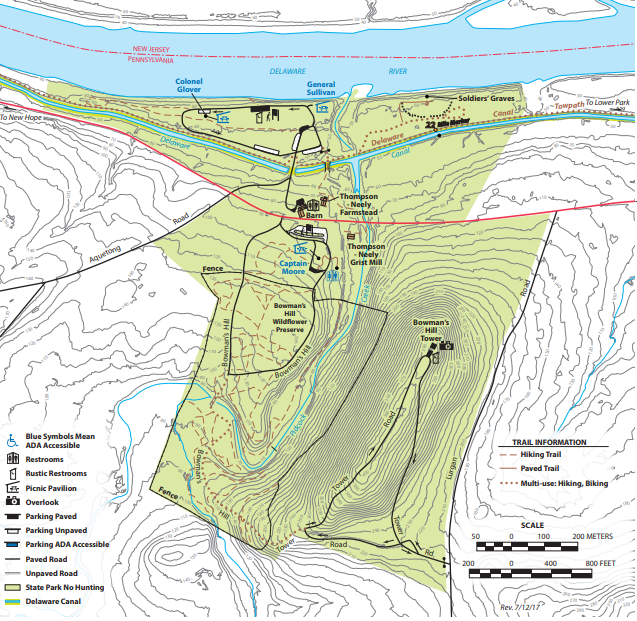 Uhlerstown, “The Best Preserved Hamlet in America”: Mile Marker 40
Uhlerstown, “The Best Preserved Hamlet in America”: Mile Marker 40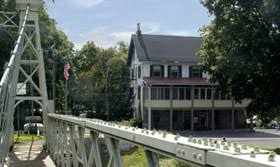 This Inn was built in 1838 by Benjamin Riegel, a wealthy miller who owned property on either side of the Delaware River. His New Jersey operations included a grist mill and an oil mill. John Riegel, the grandson of Benjamin, continued the industrial legacy of the family by adding a paper mill which became known as the Riegel Paper Company, one of the largest employers in the area until the 1990’s.
This Inn was built in 1838 by Benjamin Riegel, a wealthy miller who owned property on either side of the Delaware River. His New Jersey operations included a grist mill and an oil mill. John Riegel, the grandson of Benjamin, continued the industrial legacy of the family by adding a paper mill which became known as the Riegel Paper Company, one of the largest employers in the area until the 1990’s.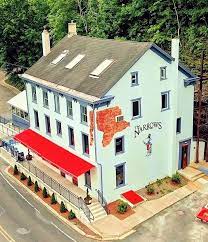 The Lenape Indian Tribe originally inhabited the site of the current Inn and restaurant. They used a deep natural pool in the rocks at the base of the Nockamixon Cliffs as a holding tank for fish they had caught in the Delaware River. When the current building was erected in 1820, owner Jacob Krouse used the rock walls of the tank as his new tavern’s foundation. The tavern license for the site dates back to 1812 when the pilots of lumber rafts were served a blicky (quart) of beer for a nickel.
The Lenape Indian Tribe originally inhabited the site of the current Inn and restaurant. They used a deep natural pool in the rocks at the base of the Nockamixon Cliffs as a holding tank for fish they had caught in the Delaware River. When the current building was erected in 1820, owner Jacob Krouse used the rock walls of the tank as his new tavern’s foundation. The tavern license for the site dates back to 1812 when the pilots of lumber rafts were served a blicky (quart) of beer for a nickel.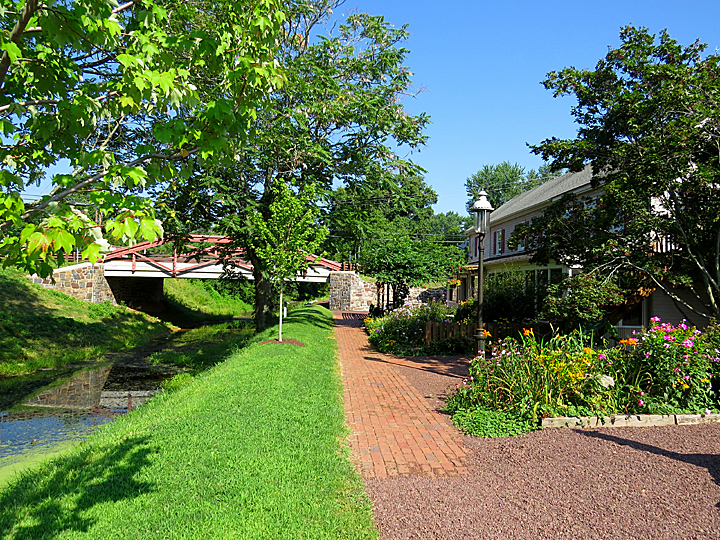 Another popular spot along the Canal is the Homestead General Store. This business has served the local community since the early 1800’s and is the oldest continuously operating general store in Bucks County providing provisions as well as a place to trade some canal gossip.
Another popular spot along the Canal is the Homestead General Store. This business has served the local community since the early 1800’s and is the oldest continuously operating general store in Bucks County providing provisions as well as a place to trade some canal gossip.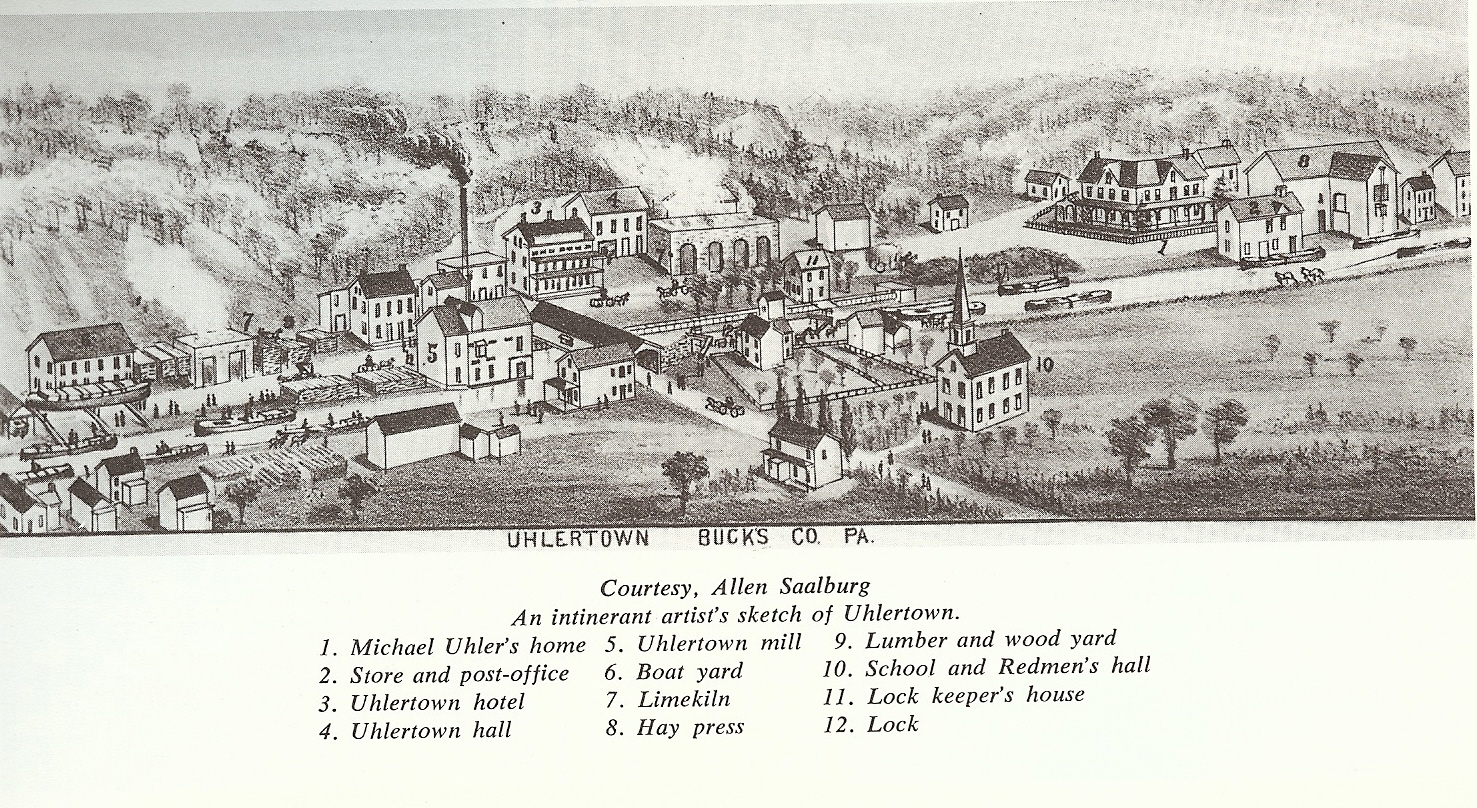 Now a private residence, the Uhlerstown Hotel was once a favorite resting spot for weary travelers. Built around 1840, the hotel was added to the National Register of Historic Places in 1994. Today, the entire hamlet is listed as a historic district.
Now a private residence, the Uhlerstown Hotel was once a favorite resting spot for weary travelers. Built around 1840, the hotel was added to the National Register of Historic Places in 1994. Today, the entire hamlet is listed as a historic district.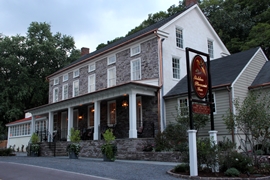 Originally called the Delaware House, the Golden Pheasant Inn was built in 1857 to cater to the canal trade. The Inn offered housing for men and mules along with provisions. When the Canal closed in 1931, the Inn suffered hard times until 1967, when it was purchased by Ralph Schneider, who named it the Golden Pheasant Inn.
Originally called the Delaware House, the Golden Pheasant Inn was built in 1857 to cater to the canal trade. The Inn offered housing for men and mules along with provisions. When the Canal closed in 1931, the Inn suffered hard times until 1967, when it was purchased by Ralph Schneider, who named it the Golden Pheasant Inn.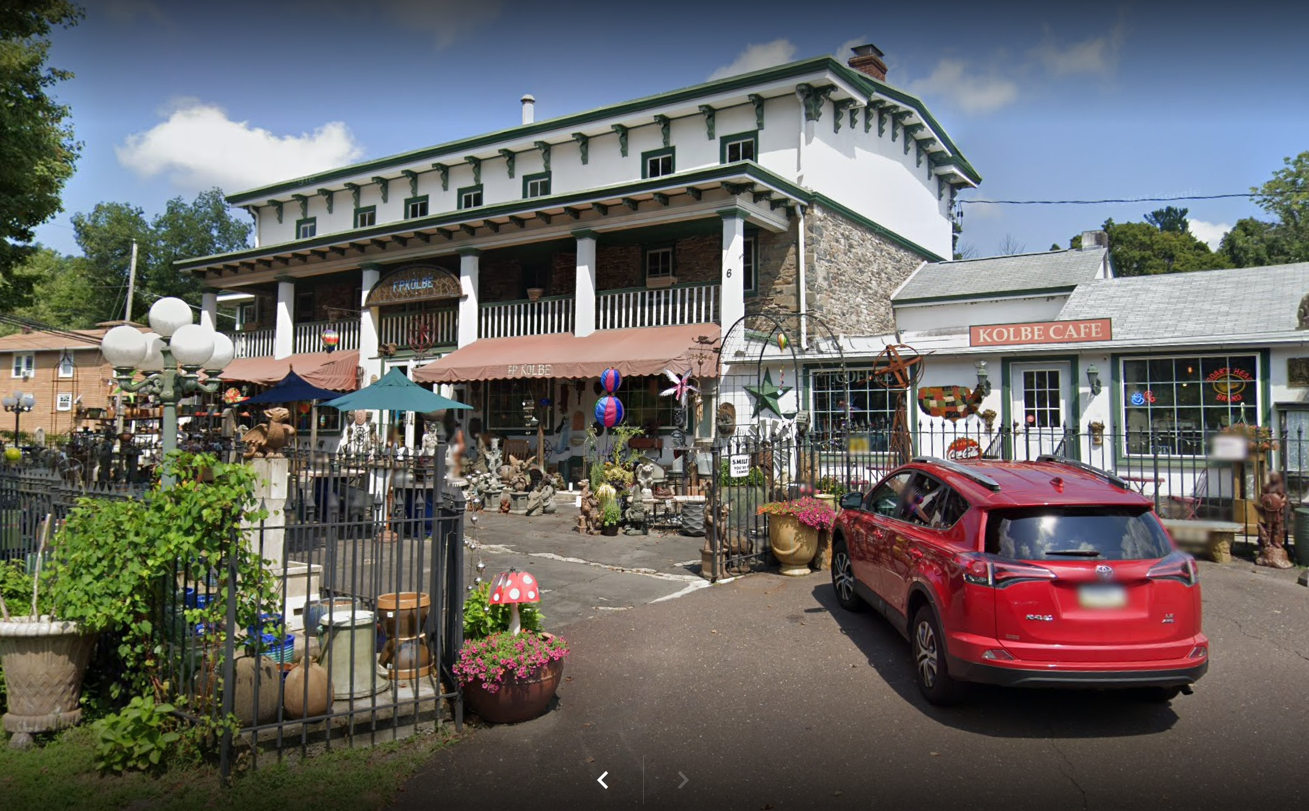 At one time, Point Pleasant was a bustling commercial center largely catering to the canal and carriage trade and then to vacationers who discovered the charms of this river valley town.
At one time, Point Pleasant was a bustling commercial center largely catering to the canal and carriage trade and then to vacationers who discovered the charms of this river valley town.